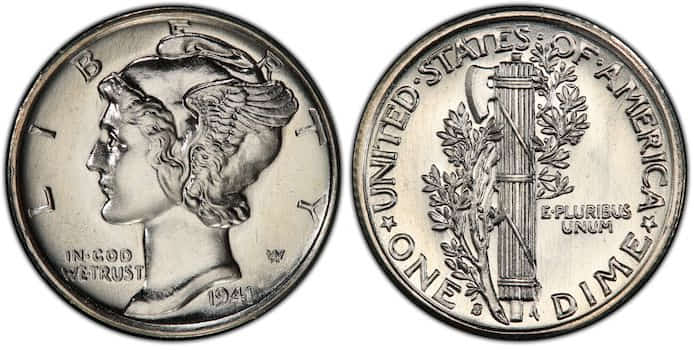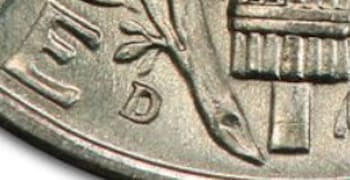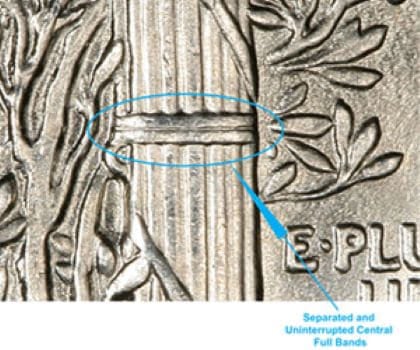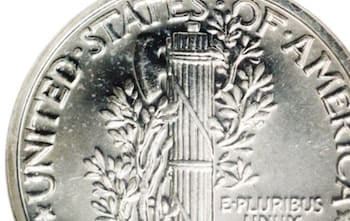Ed. note: This article is periodically updated to reflect the current price of most valuable coins.
In Coleccionistas de Monedas, we fight against the misinformation surrounding the world of coins on the web. For this reason, our articles are written 100% by people (not AI), and we link to all sources and references for coin prices, so you can have real, updated, and reliable information.
1941 Mercury Dime Values
Coleccionistasdemonedas.com estimates the value of a 1941 Mercury Dime to be:
1941 Mercury Dime Price Chart
The 1941 Mercury Dime is a coin that holds more than one surprise. Its price range can vary from just a few dollars to over $17,000 in 2019. It’s important to note that we are always discussing coins in perfect condition: Mint state. In the case of the Denver minting, the maximum price was reached in 2023 for a 1941-D Mercury Dime MS with an MS68 quality, which achieved $9,000 in March.
| Mercury Dime Variety | MS60 | MS61 | MS62 | MS63 | MS64 | MS65 | MS66 | MS67 | MS68 |
|---|---|---|---|---|---|---|---|---|---|
| P (Philadelphia) | $8 | $8 | $9-10 | $16-17 | $20-22 | $25-28 | $35-40 | $70-115 | $425-1,750 |
| P (Philadelphia) Full Bands (FB) | $9 | $10 | $11-12 | $16-18 | $22-26 | $40-50 | $60-95 | $165-700 | $4,000-17,500 |
| D (Denver) | $9 | $9 | $12-14 | $16-17 | $20-22 | $25-28 | $35-42 | $75-325 | $500 |
| D (Denver) Full Bands (FB) | $11 | $12 | $13-14 | $18-20 | $22-26 | $40-45 | $55-60 | $140-325 | $9,000 |
| S (San Francisco) | $8 | $8 | $9-10 | $14-16 | $20-22 | $25-28 | $45-55 | $100-275 | $1,000 |
| S (San Francisco) Full Bands (FB) | $12 | $16-20 | $26-28 | $35-38 | $45-50 | $60-100 | $215-550 | $4,000-7,500 | |
| S (San Francisco) Full Bands Proof Like (FB PL) | – | – | – | – | – | – | – | $1,550-2,500 | $4,500 |
JUMP TO SECTION
1941 is an important year for the United States, as it was the year in which it entered World War II, and it will last in the conflict as long as the Mercury Dime, until 1945.
Despite being a relatively common coin, due to its high issue, not all 1941 Mercury Dime have lasted to present day. This means that they have a high value if a specimen is especially well preserved, as well as if it has certain peculiarities such as Full Bands or versions with errors.
Read on to learn more…
History of the Mercury Dime (aka Winged Liberty Head)
Since 1916, succeeding the previous Dime, the Barber (1892-1916), the Mercury Dime began to be minted.
Its name comes from the resemblance of its bust to the Roman god Mercury, however, it is really a representation of freedom, and its real name would be “Winged Liberty Dime”.
It should be noted that during the period from 1916 to 1945 there were pauses in its minting, as in 1932 and 1933, due to the Great Depression.
Click here to see more info about most valuable mercury dimes series (1916-1945).
How to identify a 1941 Mercury Dime?
The 10-cent Mercury coins have the bust of a woman representing Liberty on the obverse. She wears a Phrygian cap with wings, reminiscent of the god Mercury, hence the name of the dime.
Surrounding this female bust we find the legend “LIBERTY”, which is precisely what the head represents. On the lower left side of this obverse we find the motto “IN GOD WE TRUST” which is so common on U.S. coins. Just on the opposite side of the bust, the year of issue of the coin, 1941, below the anagram with the name of the designer, Adolph Alexander Weinman.
On the reverse we find right in the center some fasces, a Roman symbol that represents unity and strength, since it is made up of many rods joined together, which gives us to understand that the strength is born from this union. In addition, the fasces are surrounded by olive branches, symbolizing peace. Also in the center, to the right of the symbol appears the motto “E. PLURIBUS UNUM” (from many, one).
Surrounding the fasces are two legends in a semicircle. At the top is the name of the issuing country “UNITED. STATES. OF. AMERICA”, and at the bottom the denomination of the coin “ONE DIME”.
Characteristics
As for its characteristics, they are as follows:
- It weighs 2.5 grams.
- A diameter of 17.9 millimeters.
- It is made of 90% silver, and the remaining 10% is copper.
Types of mint marks
- There may be three possible mints:
- Philadelphia: No mintmark letter.
- Denver: Marked by the letter “D” on the obverse.
- San Francisco: Marked by the letter “S” on the obverse.
The mintmark is located, if present, just to the right of the word “ONE” on the reverse.
Each mint has a different number of mintages, so they may be rarer:
- Philadelphia: 175,090,000 coins minted.
- Denver: 45,634,000 coins minted.
- San Francisco: 43,090,000 coins minted.
Normally Philadelphia is the most abundant of the 1941 Mercury Dime, and Denver and San Francisco the scarcest, and therefore most valuable.
How to know the real value of your 1941 Mercury Dime
The higher the grade, the higher the price grows exponentially, as it is a factor of great importance. U.S. coins tend to be quite abundant in medium grades, so a slight difference in grade can make them extremely rare. A year with less mintage makes higher grades even rarer.
To know the state of conservation of the coin we own or want to buy we need to have an expert eye that we can hardly acquire without time or experience. This is why it is not a bad idea to resort to a TPG (Third Party Grading Service). These are companies dedicated to evaluating and awarding a score to our coins according to their condition. In addition, they certify the authenticity and encapsulate the coin for security purposes, both for its preservation and to facilitate its sale.
1941 Mercury Dime – Higher Auction Prices
Mercury Dime Full Bands (FB)
The 1941 Mercury Dime is quite plentiful, however, there is one detail that can greatly increase its price.
For reference, we can take this 1941 Mercury Dime Full Bands from the Denver Mint, with a conservation quality MS68, which sold for $1,320 at the prestigious Heritage Auctions auction house in 2021.
On the reverse, as we have seen previously, the fasces can be appreciated and we see that there are some “bands” that tie the wooden rods. There are 3 series of bands, at the top, center, and bottom of the bundle of rods.
We have to look at this central one, since, in most Mercury Dime, the central bands are “fused”, that is to say, it is not possible to distinguish that they are two separate bands joining the fasces in the center. In the case that the two are clearly differentiated, it is said that it is a Mercury Dime Full Band.
Of course, this detail is only noticeable in coins of high quality, because due to wear it is possible that, even if it had been a Full Band in its origin, it would be indistinguishable.
Higher Auction Prices Chart for 1941 Mercury Dimes
| Year | Variety | Auction Price | Grade |
|---|---|---|---|
| 1941 | PR67 CAMEO | $4,025 | PR67 |
| 1941 | FULL BANDS | $1,320 | MS68 |
1941 Mercury Dime PROOF
There have always been collectors, and it was for them that these special coins, the PROOF editions, were intended.
Proof coins are especially well minted, as they are given a special finish thanks to the treatments in the minting process. The result is appreciable by its mirror background and its quality, normally MS65 or higher if it has been preserved in good condition.
In the case of the 1941 Mercury Dime, 16,557 of them were produced in Philadelphia, the mint in charge of the proof mintage until 1968.
The price of proof coins is usually higher than for normal coins, except for certain exceptional specimens, i.e. with MS66, MS67 or MS68 grades.
The value of a 1941 Mercury Dime PROOF is between $160 and $300. However, specimens with peculiarities can far exceed them. A good example is this 1941 Mercury Dime PR67 Cameo auctioned by Heritage Auctions for $4,025.
The cameo denomination is given to coins that have a frosted appearance on the coin as can be seen in the image.
Conclusions on the 1941 Mercury Dime
Collecting silver dimes is very interesting and eye-catching, as well as quite affordable for an average collector. In addition, the Mercury Dime from the World War II period is especially collected, starting with this one from 1941.
In general, the Mercury Dime is a coin that seems to be preserving its value very well and is even increasing over the years, so as an investment it is also wise to buy some extraordinary specimens.
As for continuing the collection, it is simple with the Mercury Dime. We have since 1916 to forge an extensive collection. The cost of a complete collection by year in MS63 quality would be between $3,194 and $3,367 according to PCGS. However, we can expand this to years and mints, making a huge collection worth over $30,000.
Depending on taste and budget, we can even incorporate some variants, or Full Bands versions, making the budget multiply by two.
We believe it is necessary to remember that coins should not be cleaned in any case, as it is common to try to leave silver coins shiny, but this takes away their original patina, making them lose value for collecting.
In case the coin is full of dirt and it is suspected that it may have some economic value, it is best to consult a professional numismatic dealer.
References and sources
- Heritage auctions
- NGC
- The Official Red book 2024: A Guide Book of United States Coins.
Numismatic Expert & Writer. BA in History and BS in Computer Science. He’s a member of the American Numismatic Association (ANA) and the Numismatic Literary Guild (NLG) and write in several digital media specialized in collecting, auctions and antiques reviews.
Expertise
He is an active investor and a member of the coin collecting community, specializing in antique United States coins. He uses this expertise to disseminate knowledge and interest in coins among the broad audience of Coin Collectors through both simple and high-level articles.
Features in Other Publications
Experience
Javier has been an active member of the coin collecting community for approximately 15 years. He has gained extensive experience during this time and wishes to share it with his readers.
Education
He completed a Bachelor’s degree in History from UNED and a degree in Computer Science from the University of Cádiz.





